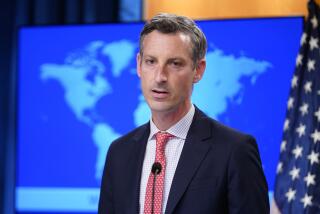8 Soviet Missile Pact Inspectors Barred as Spies
- Share via
WASHINGTON — The United States has rejected eight Soviet on-site inspectors proposed by Moscow for the medium-range missile treaty because it suspects that they are spies, informed sources told The Times on Thursday.
The eight men had been linked to Soviet intelligence activities in the past, the sources said, although not necessarily against the United States. They were rejected during a preliminary screening process before 22 Soviet treaty inspectors arrived in this country this month.
None of the American inspectors proposed were rejected by Soviet authorities, they added.
The Soviets’ proposal of these men--despite the new warmth in U.S.-Soviet relations--is seen as another sign that Soviet intelligence agencies, including the KGB secret police and the GRU military intelligence directorate, have not curbed their operations under Soviet leader Mikhail S. Gorbachev’s three-year-old perestroika, or restructuring, program.
‘No Diminution’
“There’s clearly been no diminution” of Soviet intelligence activities in the United States, according to a senior U.S. counterintelligence official. If anything, he said, “we think KGB activities have been up for the last several years.”
Canada last month expelled or barred entry by 17 Soviet officials suspected of involvement in espionage efforts. Some allegedly tried to infiltrate a U.S.-owned military contract firm in Montreal that had access to secret radar, sonar and other naval technology.
The KGB also has been particularly active in giving recent U.S. defectors and spies wide publicity, both to embarrass the CIA and FBI and to enhance recruitment by showing how well U.S. turncoats are treated there.
This week, Glenn Michael Souther, a former Navy enlisted man, surfaced in Moscow after having disappeared in 1986 and was interviewed in an hourlong Soviet television program. This spring, two spies who had fled the United States were extensively interviewed in Eastern Europe for two new books about Soviet espionage successes.
The U.S. rejection of the eight Soviet nationals came last month after the two nations, in accordance with the Intermediate-range Nuclear Forces Treaty ratified this spring, exchanged lists of prospective inspectors for “vetting,” or screening. Under the treaty, the inspectors who were cleared would visit designated missile facilities in the host country and verify that the treaty’s provisions for the elimination of all medium-range missiles were carried out.
Three Lists Supplied
Brig. Gen. Roland LaJoie, director of the On-Site Inspection Agency, told a press conference last week that three lists were supplied by each side: one for temporary inspectors who would make short-term visits; another for permanent inspectors who are to be based at the missile installations at Magna, Utah, or Votkinsk, in the Soviet Union, for the next 13 years; and a third for the crews of the aircraft flying the inspectors into the other country. The Soviet inspectors who arrived this month are now at Magna.
LaJoie refused to elaborate on the lists, but it was learned that each contained 200 names, some overlapping and appearing on more than one list. The total number of U.S. personnel proposed was about 450, sources said.
8 Culled From Lists
Sources said that the eight persons with intelligence backgrounds were culled from the Soviet inspector lists. The sources disagreed slightly as to whether one of the names was on the air-crew list as well as the temporary inspector list.
Most significantly, they said, seven of the eight Soviet citizens were to have become permanent inspectors at Hercules Plant One in Magna, Utah, which U.S. counterintelligence officials consider the facility with the greatest susceptibility to technical and human intelligence activities not permitted by the treaty.
“The Soviets have (listening) platforms and agents on the East Coast and the West Coast,” said one official, “but none in middle America. We want to keep it that way.”
Other officials have cited the possibility that a Soviet engineer could, in his private quarters at a site, modify equipment bought at a local electronics store and use it to eavesdrop on the surrounding area. Inspectors’ private quarters may not be entered by host-country guards.
Long-Running Debate
Whether more than eight Soviets with intelligence experience were identified by U.S. officials is not known. There has been a long-running debate within U.S. intelligence agencies as to whether known foreign agents should always be kept out, suggesting that some might be allowed to enter and then be monitored.
“We say ‘no’ unless we want to let them in knowingly and then do the ‘wine, women and song routine’ with them or keep close surveillance to see with whom they deal,” one source said.
“We know a lot about these people (Soviets on the inspector lists) before they ever get here,” another government source said. “Just speaking hypothetically, say one of these people had been assigned to their (Soviet) embassy in Japan and had engaged in (intelligence) activities there. We could know this from the Japanese or by other means.”
So far as is known, the Soviets have not complained about the eight rejections. As provided by the treaty protocol, no cause had to be stated for culling out the seven who would have gone to Magna; the other was rejected because he had been declared persona non grata previously, either by the United States or one of its allies.
The Soviets have “grumbled,” however, about the thoroughness with which the personal baggage of Soviet inspectors has been examined on arrival here, one official said, compared to the relatively light treatment U.S. baggage receives there.
More to Read
Sign up for Essential California
The most important California stories and recommendations in your inbox every morning.
You may occasionally receive promotional content from the Los Angeles Times.













